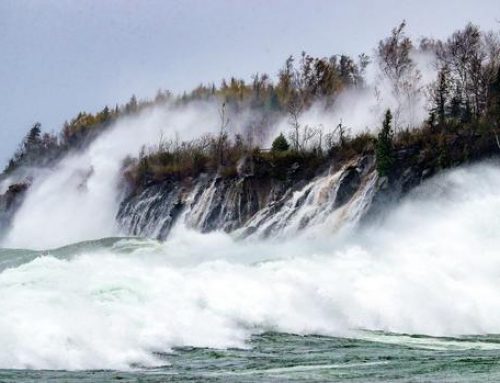If you live in Michigan and have listened to the news lately, it is likely that you have heard about the various instances of PFAS contamination in our water. With PFAS showing up in at 30 different sites at affecting 15 different communities. PFAS is an extremely dangerous chemical to humans and wild life that lingers in the environment for so long they are referred to as “forever chemicals.” It has the ability to build up at the surface of the water and be whipped into a foam which can float down rivers or across lakes onto our beaches. It is good practice to keep you children away from these piles of sea foam for the foreseeable future. As fun as it was to play in these piles of foam as children they now serve as repositories of concentrated PFAS. The research is still being completed to know the true affects of exposure to the chemical however the EPA has already linked PFAS to lower birth rates, immune system troubles, thyroid problems and cancer. The federal level for a “health advisory” due to PFAS is 70 parts per trillion. To put that in prospective, one part per trillion would be equal to a single grain of sand inside a swimming pool. With the chemical being odorless and tasteless you do not know you are being affected until it is too late.
PFAS originated with the DuPont chemical companies use of it in their Teflon products as far back as 1938. Companies began to notice the affects of the chemical on their workers as far back as the 1970’s and by the 2000’s many companies started to phase out its use.
The sources of PFAS in our water are varied throughout the state. An Air Force airfield in the northeastern part of Michigan’s lower peninsula deployed a common practice of using fire extinguishers comprised of PFAS laced foam as a powerful fire retardant used to combat burning jet fuel. Another source in western Michigan originated at Wolverine Worldwide, a boot company north of Grand Rapids in Rockford Michigan. The company used Scotchgard water repellent, which contains PFAS, to protect their boots for decades. A second western Michigan community, Parchment Michigan, is facing contamination due to a shuttered paper mill. Although many companies in the United States have transitioned away from using the chemical, many international companies still use it with impunity.
The governments of our Great Lakes States and the federal government as a whole have not come up with a plan to combat the spread of the chemical nor have they announced how long it will take to clean up. The federal government and most states have not even decided on what levels are considered safe or dangerous in the drinking water. Only New Jersey, Minnesota and Vermont have come up with standards and they are all different. Unfortunately the Michigan senate is currently looking to pass a bill in the lame-duck period of 2018 that would allow residents to be exposed to higher levels of the chemical and hamstring the abilities of affected communities to clean up contaminated areas.
With studies still incomplete, it will be years before we know how many people have been impacted, how much of our ground water is contaminated and what the final bill will be for cleaning up the problem. For a map showing all the confirmed locations that have been affected refer to this map provided my the Michigan Department of Environmental Quality. If you want to see the most up to date responses and testing results the state of Michigan is taking refer to the PFAS response at Michigan.gov. When you are out on the water this season please be aware if you are in a contaminated area and take all precautions to limit your exposure to this dangerous chemical.
Photo Credit to MLive: https://www.youtube.com/watch?v=5ockhN-3Zks






